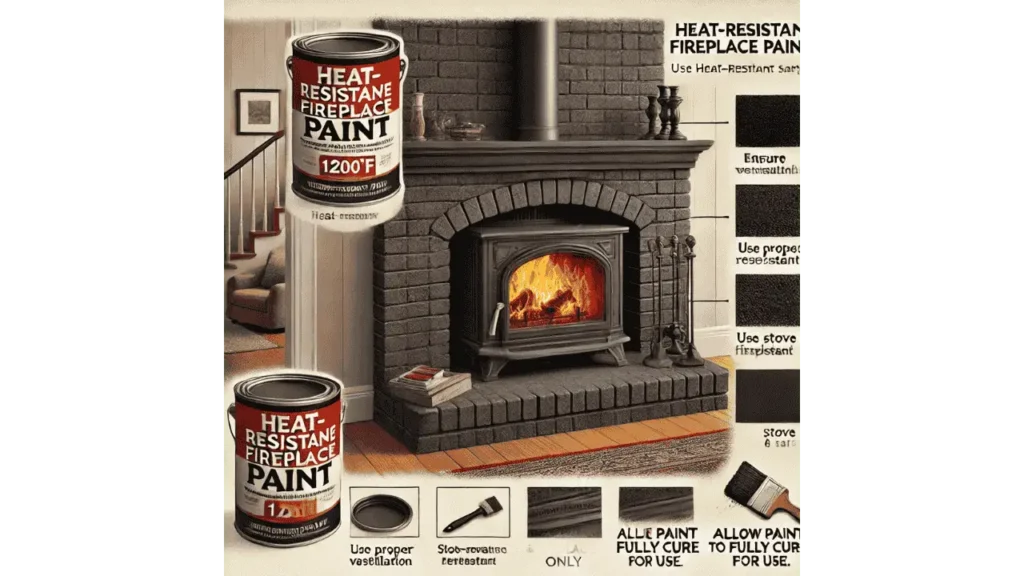Painting the inside of a fireplace is a great way to refresh its appearance and give your living space a new look. Whether you want to cover soot stains or simply update the aesthetic, using the right materials and techniques is crucial to ensure a long-lasting and safe finish. Before starting, it’s important to understand what type of fireplace you have and whether painting is a suitable option.
Step 1: Invest in Interior Fireplace Paint
Choosing the Right Paint
Choosing the right paint is the most important step when painting the inside of your fireplace. Not all paints can withstand the high temperatures generated by a fireplace. Look for heat-resistant, high-temperature paint specifically designed for fireplace interiors. These paints are typically rated to withstand temperatures up to 1200°F, ensuring they remain intact without peeling or discoloration.
Color and Finish Options
It’s also essential to choose a paint that is non-toxic and safe for indoor use. Many fireplace paints come in matte black, but there are other colors available to match your desired style. Consider finishes that complement your home decor while providing durability and longevity.
Step 2: Prepare to Paint the Fireplace Interior
Gathering Supplies
Proper preparation is key to achieving a professional-looking result. Start by gathering all necessary supplies, including paint brushes or rollers designed for high-heat applications, painter’s tape, drop cloths, and protective gear such as gloves and a mask.
Prepping the Area
Remove any existing debris from the fireplace and cover the surrounding areas with drop cloths to protect against accidental paint splatter. Ventilate the room well by opening windows or using a fan to ensure proper airflow during the painting process.
Learn More: Stopping Draft from Direct Vent Fireplace
Repairing Damage
If your fireplace has existing cracks or damage, consider repairing them with heat-resistant filler before painting to achieve a smooth, even surface.
Step 3: Deep Clean the Inside of Your Fireplace
Removing Loose Debris
Before painting, it’s crucial to thoroughly clean the fireplace interior to remove soot, ash, and grime. Use a stiff brush or a vacuum cleaner with a brush attachment to clear loose debris.
Cleaning Solutions
For deeper cleaning, mix a solution of warm water and a mild detergent, then scrub the surfaces with a sponge or brush. For stubborn stains, consider using a fireplace cleaning solution or a mixture of baking soda and vinegar.
Drying the Surface
Allow the cleaned surfaces to dry completely before proceeding with painting to ensure proper adhesion of the paint. A clean surface will help the paint bond better and last longer.
Step 4: Paint the Inside of Your Fireplace
Applying Primer
Once the fireplace is clean and dry, it’s time to start painting. Begin by applying a thin, even coat of heat-resistant primer if recommended by the paint manufacturer. Allow the primer to dry completely before applying the topcoat.
Painting Techniques
Using a high-heat-resistant paint brush or roller, carefully apply the paint in even strokes, covering all interior surfaces. Allow each coat to dry thoroughly before applying additional layers for optimal coverage and durability. Typically, two coats of paint are sufficient for a uniform finish.
Final Touches
After the final coat has dried, inspect the fireplace for any missed spots and touch up as needed. Once the paint has fully cured, your fireplace will have a fresh, new look that’s both stylish and functional.
Best Practices for a Successful Project:
Ventilation and Safety Measures
Working in a well-ventilated area is crucial when painting a fireplace. Proper airflow helps disperse fumes from high-temperature paint and ensures a safe working environment. Wearing protective gear such as masks and gloves prevents exposure to harmful chemicals.
Choosing the Right Tools
Using high-quality brushes and rollers specifically designed for high-heat applications ensures an even application and better coverage. Investing in the right tools makes the painting process smoother and results in a more professional finish.
Curing Process
After painting, allow adequate time for the paint to cure before using the fireplace. Most high-temperature paints require a curing period, which involves gradually increasing the heat to help the paint bond and harden properly.
Maintenance Tips
Regular maintenance helps prolong the life of the painted fireplace. Periodically check for signs of wear, discoloration, or peeling paint, and address any issues promptly. Cleaning the fireplace regularly also helps maintain its appearance.
Conclusion:
Painting the inside of a fireplace can revitalize its appearance and enhance your home’s décor. By selecting the right heat-resistant paint, preparing the area properly, and applying the paint with care, you can achieve a durable and attractive finish. With these steps, your fireplace can become a focal point that adds warmth and charm to your living space. Regular maintenance and occasional touch-ups will help keep your painted fireplace looking great for years to come.
- 27 Farmhouse Fireplace Ideas That Bring Warmth & Charm - August 18, 2025
- 25 Fireplace Lighting Ideas to Illuminate Your Hearth - August 7, 2025
- How to Replace an Electric Fireplace Switch? - August 5, 2025



